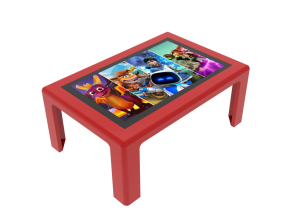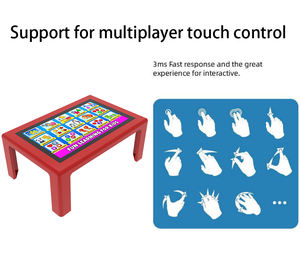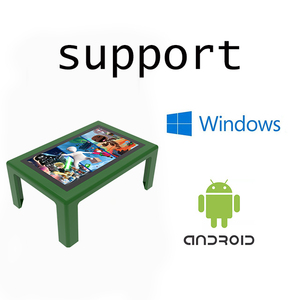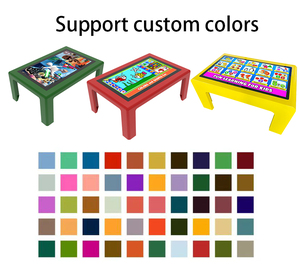(31170 products available)








































































































































































































A table with a touch screen is a large display with a touch sensor that enables users to interact directly with content by touching the screen. These large touchscreen tables are popular in schools, businesses, and public places because they allow multiple users to engage with the screen simultaneously, making them ideal for group work and presentations. There are several types of touchscreen tables, including the following:
Capacitive Touchscreen Tables
Capacitive touch screen tables use capacitive coupling to detect touch. The screen is made of glass with a conductive coating. When a user touches the screen, the capacitance changes, and the location of the touch is registered. These tables are very responsive and support multi-touch gestures. They are widely used in consumer electronics, like smartphones and tablets.
Resistive touchscreen tables
These tables have a screen made of two flexible, conductive layers separated by a thin gap. When the top layer is pressed against the bottom layer, it completes a circuit, and the touch is registered. They are less expensive to produce and work well with gloved hands or styluses. However, they do not support multi-touch gestures and have lower clarity and sensitivity compared to capacitive touch screen tables.
Infrared Touch Screen Tables
Infrared touch screen tables have a grid of infrared light beams (either above the screen or embedded in the bezel) that create a detection area. When an object (like a finger) touches the screen and interrupts the beams, the location of the touch is determined. They are durable, support multi-touch, and work in any lighting condition. They are often used in public kiosks and large display screens.
Optical Touchscreen Tables
These tables use cameras (usually located in the corners) to detect touches by tracking the points of intersection of the cameras' light beams. They are easy to build, support multi-touch, and work without special gloves or stylus. However, they may have reduced accuracy in bright light or crowded environments. They are commonly used in large interactive displays.
Surface Acoustic Wave (SAW) Touchscreen Tables
SAW touch screen tables have transducers on the screen's surface. When a finger touches the screen, it disrupts the acoustic wave, and the touch is registered. They are very clear, durable, and support multi-touch. However, they may be less common than other types and more sensitive to dirt and water.
Multi-Touch Tables
Multi-touch tables are designed to detect multiple points of contact simultaneously. They use capacitive or optical technologies to enable gestures like pinching, zooming, and rotating. These tables are popular for collaborative work, interactive exhibits, and gaming, as they allow several users to interact with the screen simultaneously.
Touch screen smart coffee tables have become an integral part of modern life. They provide a unique and interactive way to connect with the digital world. Their features vary widely based on their intended use, whether for gaming, information sharing or as a smart hub for the home. Some of their critical features include:
Multi-Touch Capability
Multi-touch capability is a key feature of smart coffee tables with touch screens. It allows several users to interact with the table simultaneously. This feature transforms the table into an interactive centerpiece for social gatherings and family get-togethers. Multi-touch capability is beneficial for collaborative tasks like brainstorming sessions or group project work. Users can perform gestures like pinching to zoom in or spreading their fingers to zoom out on images, maps, or documents. This makes the tables ideal for presentations in professional settings.
High-Resolution Display
High-resolution display is another important feature of tables with touch screens. A high-resolution display transforms the coffee table into a vibrant visual centerpiece. The stunning images capture the attention of friends and family, making it a great conversation starter. Tables with high-resolution displays offer crystal-clear graphics and text. This enhances the gaming experience by enabling users to see intricate details and read text easily. They are also ideal for viewing photos, as the color reproduction is accurate and the images are sharp.
Connectivity Options
Connectivity options refer to the different ways in which a touchscreen coffee table can connect to other devices and networks. They allow the table to interact with other devices and expand its functionality. Most touchscreen coffee tables have USB ports. They enable users to plug in devices like flash drives, keyboards, and mice directly to the table, facilitating file transfer and device control. Bluetooth connectivity allows users to connect their smartphones, tablets, and other Bluetooth-enabled devices wirelessly.
Customizable Interface
The customizable interface allows touchscreen coffee tables to adapt to users' needs and preferences. This feature transforms the tables from simple furniture into personalized interactive hubs. A customizable interface gives the user control over the layout. It enables users to place their most-used apps on the home screen. This makes access to them faster and easier. Some tables allow users to change the background. This could be a favorite image, a calming nature scene, or a sleek, modern design that fits the user's style.
There are several applications of tables with touch screens. This includes:
Education
Touch screen tables are common in the education sector. Teachers use them to create engaging lessons and interactive displays. They also use them to display assignments and students' work. Touch screen tables make lessons interesting and memorable. Students can work in groups to solve problems or carry out research. They can also use educational apps to learn different subjects. Touch screen tables are also useful in special education. They have interactive features that help students with disabilities to learn better.
Healthcare
Healthcare providers use touch screen tables for different tasks. They use them to keep patients' records, schedule appointments and manage billing. Touch screen tables are also useful in telemedicine. They enable doctors to consult with patients who are in different locations. Touch screen tables can also be used in hospitals. Patients can use them to learn more about their conditions and treatment options.
Business
Many businesses have adopted touch screen tables. This includes restaurants, hotels and retail stores. Restaurants use touch screen tables to display the menu and take orders. Customers can use touch screen tables to check-in at hotels and make payments. Touch screen tables are useful in retail stores. They enable customers to check product availability, make orders and read reviews.
Conferences and events
Touch screen tables are popular in events and conferences. They can be used to display event schedules and information. Attendees can use them to find their way around and get more details about the event. Touch screen tables are also useful for networking. Attendees can exchange contact information and connect with each other.
Home
Touch screen tables can be used at home for different tasks. They can be used to browse the internet, watch movies and play games. Families can use them to plan their schedules and create to-do lists. Touch screen tables are also useful for cooking. They enable users to access recipes and watch cooking tutorials.
When choosing a touch screen coffee table for sale, business owners must consider several factors. Here are some of them:
Consider the Size and Compatibility
The size of the touch screen table should be compatible with the available space. Buyers should stock tables in different sizes to cater to different customers' needs and preferences. More importantly, touch screen tables should be compatible with other devices, such as projectors, smartphones and gaming consoles.
Durability and Build Quality
Choose touch screen coffee tables made of high-quality materials. Such tables not only look good but are also durable. Look for options like tempered glass or sturdy wood for the top and a strong metal frame.
Interface and Connectivity
A good touch screen table should have multiple connectivity options. This allows easy connections with other devices. As a result, users can enjoy a seamless experience. The options can include USB ports, HDMI and Bluetooth.
Ease of Use and Setup
Touch screen tables are used in presentations, meetings and collaborative tasks. Therefore, choose models that are easy to set up and use. Also, consider tables that come with user-friendly features and instructions. Tables that require complex installation procedures are likely to disappoint customers.
Multifunctionality
Some touch screen tables serve multiple purposes. For instance, some transform into dining tables or can be used as workstations. Touch screen coffee tables that can be used for different applications will attract more customers.
Touchscreen Technology
Touch screen tables can have capacitive, infrared, resistive or optical touch technology. The capacitive touch technology is popular because it is highly responsive. It offers seamless interaction and multitouch support. The choice of touch technology will depend on the intended use and budget.
Consider the Aesthetics
The aesthetics of the touch screen table matter a lot. Choose tables that have visually appealing designs. The tables should complement the existing decor of the intended space. Also, opt for tables with finishes that blend in with different customers' preferences and lifestyles.
Q1: Can a touch screen table be customized for specific applications?
A1: Many modern touch screen tables can be tailored to meet particular needs. This customization might include creating specialized software for activities like interactive presentations, data visualization, or gaming. It may also involve altering the table's design to match particular aesthetic requirements or functional uses.
Q2: What kind of maintenance does a touch screen table require?
A2: To ensure the touch screen table remains in good condition, it must be properly maintained. This involves regularly cleaning the screen using the recommended cleaning materials to prevent scratches and damage. It's also important to update the software consistently and check the hardware for any issues that may affect performance.
Q3: What are the primary differences between capacitive and resistive touch screens?
A3: The main difference between capacitive and resistive touch screens is how they detect touch. Capacitive screens detect touch through the body's electrical conductivity and usually result in a clearer display and more responsive experience. On the other hand, resistive screens require pressure to touch the screen and are often more affordable but less responsive.
Q4: Are touch screen tables suitable for outdoor use?
A4: While some touch screen tables can be used outdoors, most are built for indoor use only. Touch screen tables made for outdoor use have anti-glare screens to enhance visibility in bright light. They are also constructed with weather-resistant materials to withstand different climatic conditions.
Q5: What sizes do touch screen tables come in?
A5: Touch screen tables come in various sizes to meet different needs and spaces. Small touch screen tables are suitable for personal use or in confined areas, such as home offices or small conference rooms. Medium-sized tables are ideal for public spaces like libraries and cafes, whereas large touch screen tables are designed for high-traffic areas such as exhibition halls and corporate lobbies.